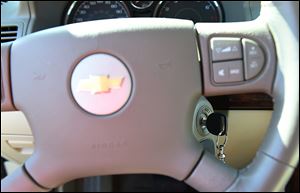
FAULTY IGNITION SWITCH
Investigation does little to assuage anger at GM
Critics: Probe fails to address key questions
6/8/2014
Valukas
ASSOCIATED PRESS

The report said GM ordered dealers to tell customers who com-plained about abrupt motor shut offs not to use heavy key rings.
DETROIT — As far back as 2002, General Motors Co. engineers starting calling it the “switch from hell.”
It would take a dozen years, more than 50 crashes, and at least 13 deaths for the automaker to recall the ignition switch, used in millions of small cars.
An internal inquiry GM released Thursday lays out a narrative of incompetence and neglect, with scores of employees and committees failing to recognize the defective part — which could abruptly shut off air bags and power steering — as a safety concern.
But even as GM owned up to the failures, the report failed to answer key questions about how and why key decisions were made.
The report never explains how a lone engineer in a global automaker could approve a less expensive part that failed to meet GM standards. Nor does it illuminate why the same engineer could substitute an improved design without changing the part number, a move critics cite as cover-up evidence. The report does say GM’s top management never knew of the problems until January; it blamed poor judgment by lower-level employees.
The internal report sought to get ahead of investigations by the National Highway Traffic Safety Administration, the Department of Justice, and Congress. Some observers were not impressed.
“It seems like the best report money can buy,” said Sen. Richard Blumenthal (D., Conn.). “It absolves upper management, denies deliberate wrongdoing, and dismisses corporate culpability.”
GM Chief Executive Mary Barra on Thursday outlined the findings for more than 1,000 GM employees at the automaker’s technical center in Warren, Mich. GM fired 15 people, including the engineer responsible for the switch design and subsequent changes. Many of those fired were executives. Five more GM employees were disciplined.
The inquiry, by former U.S. Attorney Anton Valukas, relied on hundreds of interviews and more than 41 million documents.
“I can tell you the report is extremely thorough, brutally tough, and deeply troubling,” Ms. Barra said. “It is enormously painful to have our shortcomings laid out so vividly.”
But Ms. Barra, questioned repeatedly at the news conference, said she could not explain why engineers at GM approved a switch that did not meet the company’s performance standards.
The ignition problem affected about 2.6 million Chevrolet Cobalts and other small cars, mostly from the 2003 to 2007 model years. Occupants were killed or injured because the switch could shut down abruptly in certain conditions, such as driving on rough roads or when the driver had a heavy key ring.
GM has acknowledged 13 deaths, but U.S. safety regulators believe that more people died because of the defect.
Mr. Valukas’ report said the switch issue festered for more than a decade partly because of a lack of communication.
“The report highlights a company that operated in silos,” Ms. Barra said, “with a number of individuals seemingly looking for reasons not to act, instead of finding ways to protect our customers.”
The report did not find a GM conspiracy to cover up the facts or evidence that employees made a trade-off between safety and cost.
Instead, it identified Ray DeGiorgio, who led the team that developed the switch and later improved it, as the main culprit.
Mr. DeGiorgio was one of those fired, as was Gary Altman, who directed Cobalt’s engineering team.
Mr. DeGiorgio started working on the switch in the late 1990s for GM’s new small-car program. It was designed to go into vehicles that included Chevrolet’s Cobalt sedan and HHR station wagon, the Saturn Ion sedan, and the Pontiac Solstice sports car.
Mr. DeGiorgio finalized the design in 2001 — even though he knew the switch did not meet GM’s standards, the report stated. By mid-2001, the switch was causing stalls in prototypes of the Saturn vehicle.
GM engineers believed an improvement in the tools used to make the part had fixed the problems, and Mr. DeGiorgio cleared the switch for production in 2002.
After the first cars went on sale, GM heard complaints from customers, employees, and dealers. But “group after group and committee after committee within GM that reviewed the issue failed to take action or acted too slowly,” the report said.
Engineers, the report said, did not understand how the car was built. Some thought air bags would deploy when the switch was turned to the “off” or “accessory” position. But GM had designed the air bags to shut off to protect people in parked cars. So GM viewed the problem as a customer convenience issue rather than a safety issue.
By 2007, a Wisconsin trooper investigating an accident and a research team from Indiana University had figured out the connection between the switch and the air-bag system, the report said. But the Valukas probe found that the automaker filed the information away or ignored it.
The automaker also worked hard to make it look as if the defect was not a safety problem. In 2005, it sent instructions to dealers to tell customers who complained about the cars turning off to remove heavy items from their key rings. GM made sure the instructions, known as a “technical service bulletin,” did not use the word “stalling” because that would make customers think it was a safety issue, the report stated.
Mr. DeGiorgio eventually authorized a change that increased the amount of force it would take to turn the switch, the report said. But he didn’t change the part number, which is a standard procedure, Ms. Barra said.
GM figured out the extent of the problem only when a victim’s attorney X-rayed ignition switches from pre-2008 and post-2008 model year Cobalts and found differences in the part.
Even then, it took almost another year for GM to launch recalls, the report said.